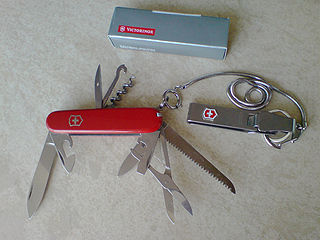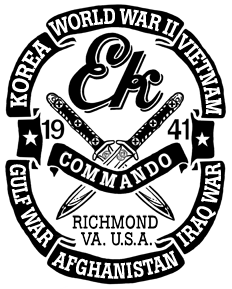
A knife is a tool with a cutting edge or blade attached to a handle. Mankind's first tool, knives were used at least two-and-a-half million years ago, as evidenced by the Oldowan tools. Originally made of rock, bone, flint, and obsidian, over the centuries, in step with improvements in metallurgy or manufacture, knife blades have been made from bronze, copper, iron, steel, ceramics, and titanium. Most modern knives have either fixed or folding blades; blade patterns and styles vary by maker and country of origin.

A bayonet is a knife, sword, or spike-shaped weapon designed to fit on the end of the muzzle of a rifle, musket or similar firearm, allowing it to be used as a spear. From the 17th century to World War I, it was considered the primary weapon for infantry attacks. Today, it is considered an ancillary weapon or a weapon of last resort.

A shuriken is a Japanese concealed weapon that was used as a hidden dagger or metsubushi to distract or misdirect.

The Swiss Army knife is a pocketknife or multi-tool manufactured by Victorinox. The term "Swiss Army knife" was coined by American soldiers after World War II due to the difficulty they had in pronouncing "Offiziersmesser", the German name.
A blade is the portion of a tool, weapon, or machine with an edge that is designed to puncture, chop, slice or scrape surfaces or materials. Blades are typically made from materials that are harder than those they are to be used on. Historically, humans have made blades from flaking stones such as flint or obsidian, and from various metal such as copper, bronze and iron. Modern blades are often made of steel or ceramic. Blades are one of humanity's oldest tools, and continue to be used for combat, food preparation, and other purposes.

A Bowie knife is a pattern of fixed-blade fighting knife created by James Black in the early 19th century for Jim Bowie, who had become famous for his use of a large knife at a duel known as the Sandbar Fight.

A tomahawk is a type of single-handed axe from North America, traditionally resembling a hatchet with a straight shaft. The name came into the English language in the 17th century as an adaptation of the Powhatan word.

Cutlery includes any hand implement used in preparing, serving, and especially eating food in Western culture. A person who makes or sells cutlery is called a cutler. The city of Sheffield in England has been famous for the production of cutlery since the 17th century and a train – the Master Cutler – running from Sheffield to London was named after the industry. Bringing affordable cutlery to the masses, stainless steel was developed in Sheffield in the early 20th century.

A kunai is a Japanese tool thought to be originally derived from the masonry trowel. The two widely-recognized variations of the kunai are short kunai and the big kunai. Although a basic tool, in the hands of a martial arts expert, the kunai could be used as a multi-functional weapon. The kunai is commonly associated with the ninja, who used it to gouge holes in walls. Many popular manga and ninjutsu characters use kunai as both their primary and secondary weapons.
A stiletto is a knife or dagger with a long slender blade and needle-like point, primarily intended as a stabbing weapon.

The Opinel company has manufactured and marketed a line of eponymous wooden-handled knives since 1890 from its headquarters in Saint-Jean-de-Maurienne, Savoie, France — where the family-run company also operates a museum dedicated to its knives. The company sells approximately 15 million knives annually. Opinel knives are made of both high carbon and stainless steel, the latter being the highest quality Sandvik steel from Sweden.

A ballistic knife is a knife with a detachable blade that can be ejected to a distance of several yards by pressing a trigger or operating a lever or switch on the handle. Spring-powered ballistic knives briefly gained notoriety in the United States in the mid-1980s after commercial examples were marketed and sold in the United States and other Western countries. Since then, the marketing and sale of ballistic knives to civilians has been restricted or prohibited by law in several countries.

A trench knife is a combat knife designed to kill or gravely incapacitate an enemy combatant at close quarters, as might be encountered in a trenchline or other confined area. It was developed in response to a need for a close combat weapon for soldiers conducting assaults and raids on enemy trenchlines during the First World War. An example of a World War I trench knife is the German Army's Nahkampfmesser.

A kitchen knife is any knife that is intended to be used in food preparation. While much of this work can be accomplished with a few general-purpose knives – notably a large chef's knife, a tough cleaver, and a small paring knife – there are also many specialized knives that are designed for specific tasks. Kitchen knives can be made from several different materials.

The Santoku bōchō or Bunka bōchō (文化包丁) is a general-purpose kitchen knife originating in Japan. Its blade is typically between 13 and 20 cm long, and has a flat edge and a sheepsfoot blade that curves in an angle approaching 60 degrees at the point. The word may refer to the wide variety of ingredients that a Santoku knife can handle: meat, fish and vegetables, or to the tasks it can perform: slicing, chopping and dicing, either interpretation indicating a muti-use, general-purpose kitchen knife. The Santoku's blade and handle are designed to work in harmony by matching the blade's width/weight to the weight of blade tang and handle, as with the original Japanese Santoku.[1]

Ek Commando Knife Co. or Ek Knives is an American combat knife brand produced by several different companies since the original founded by John Ek in 1941. In May 2014 the Ek brand as purchased by Ka-Bar which began selling its versions of Ek knife designs in 2015. Although not officially issued gear, Ek Knives have seen use by US forces in six major conflicts: World War II, the Korean War, the Vietnam War, the Gulf War, Afghanistan, and the Iraq War. Ek Knives manufactures Bowie-style blades, daggers, and a Fairbairn-Sykes MkII. President Franklin Delano Roosevelt, Clark Gable, and General George S. Patton have been identified as Ek knife owners.
Chris Reeve Knives is an American knife manufacturing corporation with international sales and distribution headquartered in Boise, Idaho, that designs, develops, and sells folding pocket knives and fixed-blade knives. Its products include the Sebenza, Inkosi, Umnumzaan, TiLock, Mnandi folding knives, Impinda slip joint, and the Green Beret, Pacific, Professional Soldier, Nyala, and Sikayo fixed blade knives. Chris Reeve Knives' industry contributions include the Integral Lock, contributions to the blade steel CPM S35VN, and has won Blade Magazine's Blade Show Manufacturing Quality Award 15 times. Their motto is Think Twice, Cut Once.
Walter Wells "Blackie" Collins was an American knife maker who designed and popularized the assisted opening mechanism and various automatic knife designs within the art of knifemaking. He is cited by other knifemakers and collectors as one of the most innovative knife designers in the world and was an author and the founder of what became Blade Magazine. Collins died July 20, 2011 in a motorcycle accident near North, South Carolina.

The French Nail were locally fabricated and converted bayonets, knives and stabbing weapons for use in the First World War. These were crude stabbing spikes made by adding a point to a steel stake which had its rearmost section heated and bent into a crude handle.


















